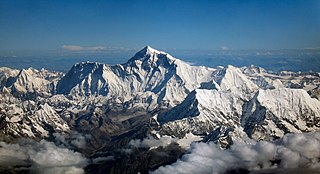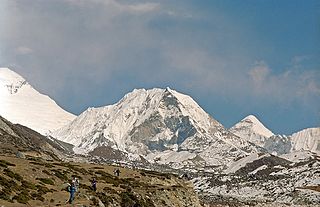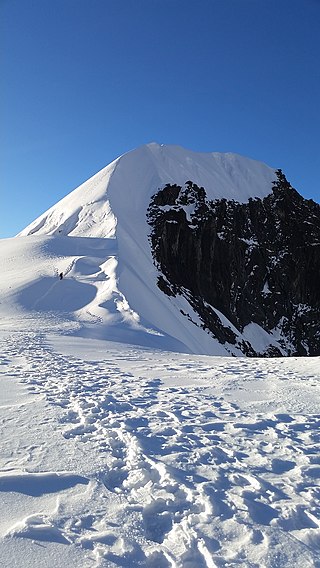
Mountaineering, mountain climbing, or alpinism, is a set of outdoor activities that involves ascending mountains. Mountaineering-related activities include traditional outdoor climbing, skiing, and traversing via ferratas that have become sports in their own right. Indoor climbing, sport climbing, and bouldering are also considered variants of mountaineering by some, but are part of a wide group of mountain sports.

Mount Everest is Earth's highest mountain above sea level, located in the Mahalangur Himal sub-range of the Himalayas. The China–Nepal border runs across its summit point. Its elevation of 8,848.86 m was most recently established in 2020 by the Chinese and Nepali authorities.

The International Mountaineering and Climbing Federation (UIAA) recognises eight-thousanders as the 14 mountains that are more than 8,000 metres (26,247 ft) in height above sea level, and are considered to be sufficiently independent of neighbouring peaks. There is no precise definition of the criteria used to assess independence, and, since 2012, the UIAA has been involved in a process to consider whether the list should be expanded to 20 mountains. All eight-thousanders are located in the Himalayan and Karakoram mountain ranges in Asia, and their summits are in the death zone.

Dhaulagiri is the seventh highest mountain in the world at 8,167 metres (26,795 ft) above sea level, and the highest mountain within the borders of a single country (Nepal). It was first climbed on 13 May 1960 by a Swiss-Austrian-Nepali expedition. Annapurna I is 34 km (21 mi) east of Dhaulagiri. The Kali Gandaki River flows between the two in the Kaligandaki Gorge, said to be the world's deepest. The town of Pokhara is south of the Annapurnas, an important regional center and the gateway for climbers and trekkers visiting both ranges as well as a tourist destination in its own right.

Manaslu is the eighth-highest mountain in the world at 8,163 metres (26,781 ft) above sea level. It is in the Mansiri Himal, part of the Nepalese Himalayas, in the west-central part of Nepal. The name Manaslu means "mountain of the spirit" and is derived from the Sanskrit word manasa, meaning "intellect" or "soul". Manaslu was first climbed on May 9, 1956, by Toshio Imanishi and Gyalzen Norbu, members of a Japanese expedition. It is said that, given the many unsuccessful attempts by the British to climb Everest before New Zealander Edmund Hillary, "just as the British consider Everest their mountain, Manaslu has always been a Japanese mountain".
The term "Trekking Peak" is a commonly misunderstood colloquial term which may refer to a variety of types of peaks in the Himalayan Region. The term is most often associated with Group "B" NMA Climbing Peaks classified by the Nepal Mountaineering Association or easier. Some may use the term "Trekking Peak" to solely describe peaks requiring little to no technical climbing experience. Others may use the term to describe all mountains regulated by the Nepal Mountaineering Association including Group "A" NMA Expedition Peaks which may require considerable difficulties and technical climbing skill.
The Nepal Mountaineering Association (NMA) is the national mountaineering association of Nepal. The NMA was founded in 1973 with the goals of promoting mountaineering activities in the Himalaya, providing safety awareness and mountaineering skills to Nepalese mountaineers and creating awareness of the beauty of the Himalayas both nationally and in international communities. The NMA is an active member of the UIAA.

Imja Tse, better known as Island Peak, is a mountain in Sagarmatha National Park of the Himalayas of eastern Nepal. The peak was named Island Peak in 1953 by members of the British Mount Everest expedition because it appears as an island in a sea of ice when viewed from Dingboche. The peak was later renamed in 1983 to Imja Tse but Island Peak remains the popular choice. The peak is actually an extension of the ridge coming down off the south end of Lhotse Shar.

Hiunchuli is a peak situated in the Annapurna massif of the Gandaki Province in north-central Nepal. The mountain is an extension of the Annapurna South. Between this peak and the Machapuchare is a narrow section of the Modi Khola valley that constitutes the sole access to the Annapurna Sanctuary.

Douglas Keith Scott was an English mountaineer, noted for being on the team that made the first ascent of the south-west face of Mount Everest on 24 September 1975. In receiving one of mountaineering's highest honours, the Piolet d'Or Lifetime Achievement Award, his personal style and climbs were described as "visionary".

Lobuche is a Nepalese mountain which lies close to the Khumbu Glacier and the settlement of Lobuche. There are two main peaks, Lobuche East and Lobuche West. A permit to climb the mountain is required from the Nepal Mountaineering Association (NMA), which classifies Lobuche East (6,119m) as a "trekking peak" and Lobuche West (6,145m) as an "expedition peak". As the easier, trekking peak, the East peak is climbed far more frequently than the West peak; however, most of those climbers only do so to a false summit a few hours from the true summit of Lobuche East. Between the two peaks is a long, deeply notched ridge, though a steep drop and considerable distance makes approaching the West peak from the East impossible.

Mera Peak is a mountain in the Mahalangur section, Barun sub-section of the Himalaya and administratively in Nepal's Sagarmatha Zone, Sankhuwasabha. At 6,476 metres (21,247 ft) it is classified as a trekking peak. It contains three main summits: Mera North, 6,476 metres (21,247 ft); Mera Central, 6,461 metres (21,198 ft); and Mera South, 6,065 metres (19,898 ft), as well as a smaller "trekking summit", visible as a distinct summit from the south but not marked on most maps of the region.

Tharpu Chuli or Tent Peak is one of the trekking peaks in the Nepali Himalaya range. The peak has a nice central position in the Annapurna Sanctuary. It is easier to climb than both Hiunchuli and Singu Chuli which also are trekking peaks of the Annapurna. The ascent requires ice climbing equipment. A climbing permit from the NMA used to cost US$350 for a team of up to four members. As of 2017 NMA has removed Tharpu Chuli from its list of Trekking Peaks.

Singu Chuli is one of the trekking peaks in the Nepali Himalaya range. The peak is located just west of Gangapurna in the Annapurna Himal. Singu Chuli is on a ridgeline originating at Tarke Kang going south. This ridge continues south of Singu Chuli to Tharpu Chuli. A climbing permit from the NMA costs US$350 for a team of up to four members. The peak requires ice climbing equipment.

Musa Ibrahim is a Bangladeshi mountaineer and an adventurer, explorer, journalist and author. He is the first Bangladeshi to claim to reach the summit of Mount Everest. He reached the summit around 5:05 am BST on 23 May 2010 and hoisted the flag of Bangladesh on the apex of the world at around 5:16 am BST. From then, Bangladesh became the 67th Mount Everest conquering country.
Love Raj Singh Dharmshaktu is an Indian mountaineer who has climbed Mount Everest seven times.

The Kyashar is a mountain peak 6769 m height in the Khumbu region in Nepal, east of Namche Bazar in the so-called Hinku Himal. It is located within the Makalu-Barun National Park.

Hari Budha Magar is a Nepalese double above-knee amputee and record-breaking mountaineer. In 2017, he became the first double above-knee amputee (DAK) to summit a mountain taller than 6,000m. On May 19, he accomplished the record of being first double above-knee amputee to summit the Mount Everest.

Subedar Major and Honorary Captain Chhering Norbu Bodh SC (retd.) is a retired personnel of the Indian Army, known for his mountaineering achievements while in the army. Bodh holds a number of Indian summiting records related to 8,000m peaks. Among others, he is the first Indian mountaineer to have climbed six of the fourteen 8000m peaks in the world, and the first Indian to stand atop Lhotse and Annapurna-1.
















